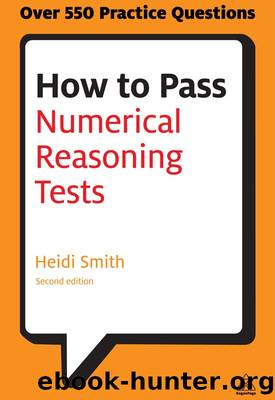How to Pass Numerical Reasoning Tests: A Step-by-Step Guide to Learning Key Numeracy Skills (Testing Series) by Smith Heidi

Author:Smith, Heidi [Smith, Heidi]
Language: eng
Format: epub, mobi
Publisher: Kogan Page
Published: 2013-05-03T00:00:00+00:00
£160
×
1 – 0.08
=
£160
×
0.92
= £147.20
Combining percentages
Percentage questions will often require that you complete the question in several stages. The questions are not difficult as long as you remember a couple of basic rules. First, remember that you cannot just combine all the percentages in a question and find the total percentage of the original whole. Second, always identify the original whole as the starting point.
Worked example
The average price of a London flat in 1970 was £40,000. By the end of the 1980s, the price had risen by 85%. By January 1992, house prices fell dramatically and the price of the same London flat, now beset with structural problems, fell by 40% on the December 1989 price. At how much more or less is the flat valued in 1992 than in 1970?
You are asked to find a new value following a percentage increase and then a percentage decrease. Increase the original whole (£40,000) by 85% (1 + 0.85) to find the December 1989 value:
40,000 × 1.85 = £74,000
New whole = £74,000
Decrease the new whole (£74,000) by 40% (1 – 0.4) to find the January 1992 value:
£74,000
×
(1 – 0.4)
=
Download
How to Pass Numerical Reasoning Tests: A Step-by-Step Guide to Learning Key Numeracy Skills (Testing Series) by Smith Heidi.mobi
This site does not store any files on its server. We only index and link to content provided by other sites. Please contact the content providers to delete copyright contents if any and email us, we'll remove relevant links or contents immediately.
How to Pass Numerical Reasoning Tests: A Step-by-Step Guide to Learning Key Numeracy Skills (Testing Series) by Smith Heidi(427)
ACFT Army Combat Fitness Test for Dummies by Papple Johnston Angie;(411)
Civil Engineering PE All-in-One Exam Guide by Indranil Goswami(370)
Batoff's Law School Secrets: Outlining for Exam Success (Career Guides) by Jeffrey S. Batoff(343)
McGraw-Hill's Police Officer Exams by Michael Palmiotto & Alison McKenney Brown(321)
Police Exams Prep 2020-2021 by Kaplan Test Prep(314)
Wiley GAAP for Governments 2020 by Warren Ruppel(312)
McGraw-Hill Education PTCE Review by Kristy Malacos(310)
Emergency Medicine PreTest Self-Assessment and Review, Fourth Edition by Adam J. Rosh(284)
CPIM Part 1 Module 2 by APICS(277)
Master the Police Officer Exam by Peterson's & Arco & Fred M. Rafilson(276)
Wiley FINRA Series 63 Exam Review 2017: The Uniform Securities Sate Law Examination by Wiley(244)
The Complete AFOQT Study Guide 2020-2021 by Todd Phillips(237)
Pass The 66: A Plain English Explanation To Help You Pass The Series 66 Exam - Updated for 2016 by Robert Walker(236)
